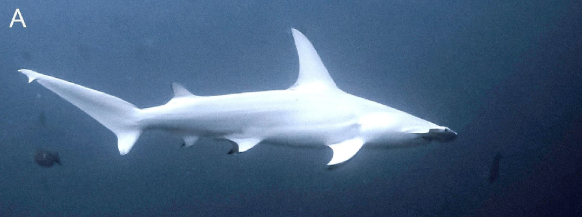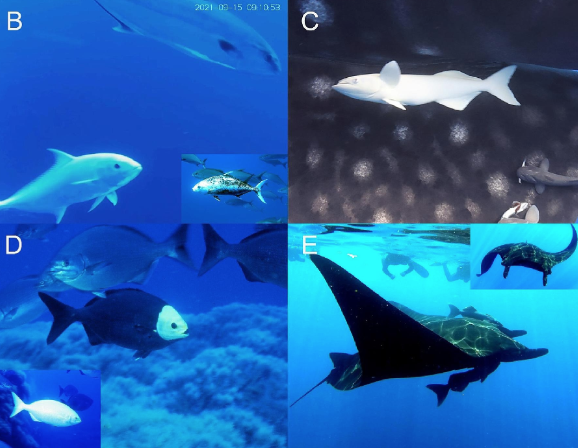Researchers have documented new records of marine fish pigmentation abnormalities, including an albino-melanistic fish, the first record of a leucistic Great Hammerhead Shark, the first record of leucistic Almaco Jacks, and the first melanistic Giant Manta ray in the North Atlantic.
In a paper published in the journal Science Direct, the scientists speculated that the new records of pigmentary abnormalities may be related to significant population declines and isolation of remote populations. Here are the species they found:

Leucistic Great Hammerhead Shark, Sphyrna mokarran
The shark was a leucistic male, critically endangered Great Hammerhead Shark, with a white body and normally pigmented eyes, filmed in September 2022, French Polynesia. The individual was estimated to measure 250–300 cm in total length.
Aberrant Almaco Jacks, Seriola rivoliana
Two aberrant Almaco Jacks were spotted in the Azores Archipelago, Portugal, one with a white body and normally pigmented eyes, filmed in August 2021, and one Almaco jack with a partially white body and normal eye coloration, in July 2022. Both fishes, estimated to be approximately 60 cm TL, were swimming in a school of 150 to 200 conspecifics, at the Ambrosio Seamount Marine Protected Area. Only one xanthochromatic Seriola rivoliana (bright yellow body) has been reported before.
Albino Remora
One albino common remora with a white body and white eyes was photographed in September 2022, offshore Pico island, in the Azores Archipelago, Portugal. The albino was found attached to the dorsal side of a pectoral fin of an adult Whale Shark, Rhincodon typus, of approximately 1100 cm TL.
Melanistic Giant Manta Ray
The first black (melanistic) giant manta, Mobula birostris from the North Atlantic, was documented in by MantaMaria Dive Center, at the Ambrosio MPA, Azores.
Albino Melanistic Sea Chub
Back in 1996, R.S Santos photographed one albino-melanistic Sea Chub, Kyphosus sp. with a white (leucistic) head and black (melanistic) body, of approximately 55 cm TL, at the offshore Formigas seamount MPA, in the Azores Archipelago, schooling with conspecifics.
Leucism
The paper states that leucism has been reported in mammals, reptiles, amphibians, and more recently elasmobranchs. More than 1250 elasmobranch species are recognized worldwide. However, to date, only 61 of those species (4.9%), including sharks, rays, and one chimaera, have been documented with albinism or leucism before, so why could it be becoming more prevalent?
In the case of the Jacks and Chub, they were found to be highly resident around the atolls and seamounts, so there the researchers suspect inbreeding. We wonder if this could also be the case for aberrant Zebrasoma scopas coming from the Maldives? In the case of the aberrant Coral beauties in the Philippines, the population showing orange coloration seems to be incredibly localized.
In the case of the pelagic and migratory sharks and rays, drastic population declines (89% in the case of the Hammerhead,) have led to much lower genetic diversity, and that will have a direct, knock-on effect with the remora populations which ride them too.
Aberrant saltwater fish are some of the most highly prized in the reef aquarium hobby, although the reasons why we are seeing some aberrations, according to this research paper, look increasingly gloomy.
More info
See New Editions to Black and White Fish Mutants, in Science Direct. https://doi.org/10.1016/j.ecolind.2023.110295



